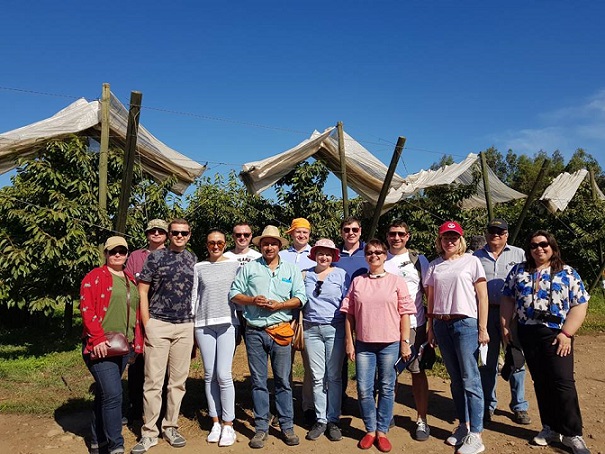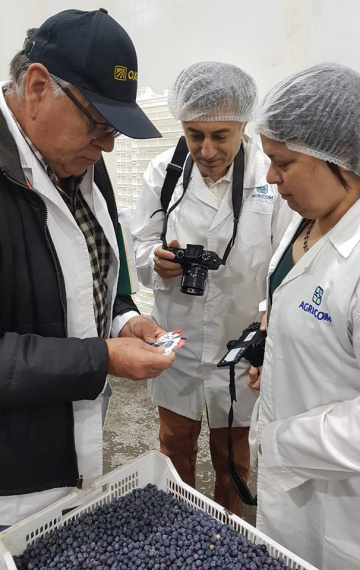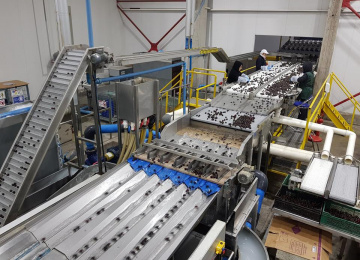
Chile is the world's leading producer and exporter of blueberries. Ukrainian entrepreneurs, who are now confidently gaining their place in the EU market, went to Chile to get useful tips for successful exporting.
In recent years, the Ukrainian blueberry sector has been demonstrating the highest growth rates in the fruit and vegetable sector in Ukraine, with a total production area of 2,100 hectares. In 2018, according to expert data, at least 700 hectares of new blueberry farms were established, a rise of 44% in one year.
“Ukraine can definitely take its place on the world market,” said Ivan Grechkovsky, CEO of the company Family Garden, which grows blueberries and raspberries over 150 hectares in the Kyiv region. However, he acknowledged that Ukrainian businesses have very strong competitors. For instance, he mentioned that Poland is a direct competitor of Ukraine, since both countries share the same berry picking season and they mostly supply to the EU market.
The leading blueberry producers in the world include Chile and the United States. Canada, Peru, Spain, Mexico, Argentina, Morocco, Netherlands, Germany, Poland, France are also among the top manufacturers and exporters of the fruit.
Chile is a leading exporter of fresh blueberries and exports more than 100,000 tons per year. Chile also exports around 30,000 tons of frozen blueberries a year. Exported blueberries from Chile are worth over $500 million.
However, Ukraine does not compete directly with Chile and other Southern and Central American countries, due to a difference in the harvesting period. For instance, Ukraine harvests blueberries mainly from June to September, whereas Chile, depending on the region, harvests the fruit from October to April.
As part of the ‘Eastern Partnership: Ready to Trade’ project, funded by the European Union under its EU4Busniess initiative, the International Trade Centre (ITC) jointly with the Ukrainian Berries Association (UBA) recently organised a study tour to Chile for Ukrainian export-oriented companies engaged in the berry sector.
“The goal of the trip to Chile was to strengthen the competitiveness of Ukrainian companies that grow and export berries,” explained Frederine Derlot, ITC fruit and vegetables specialist. During the week-long visit to Chile, Ukrainian entrepreneurs visited more than 10 farms and enterprises that grow blueberries and cherries.
The secret of success is technology and discipline.
“The Ukrainian market, especially the fresh blueberry sector, is in its infancy and lacks structure compared to the Chilean market,” says Irina Kukhtina, president of the Ukrainian Berries Association. “That is why it was interesting to see how the Chilean firms engaging in the berry sector work.” She noted that about 12% of fresh blueberries are exported to Asian countries, in particular to China. Delivery by sea takes 45 days. “It was interesting for us to learn how the Chileans have achieved such a result, with what technology they managed to ‘stretch’ the shelf life of fresh blueberries up to 90 days.”
It turns out that this is not rocket science. The success of Chileans on the global blueberry market is not associated with any special varieties of berries. It's all about discipline and strict observance of temperature mode. The cooling technology in particular allows the blueberries to be exported not only to the United States but also to Europe and China, the most profitable market where berries are sell for $5 per kilo. In Europe and the United states berries fetch a lower price - $3.5 and $2.7 per kilo respectively.
“Chile adheres to the cold supply chain,” said Ivan Grechkovsky. “Before the study tour to Chile, I did not understand how they were transporting the berries from Chile for more than 40 days. After the study tour, our company will consider the possibility of exporting to more distant countries, for example, to Asia and the United Arab Emirates.”
What is this technology? In Chile, the picked berries stay on the field for no longer than two hours. “Big enterprises have a hydro cooler on the fields. Subsequently, the vehicle that transports the berries from the fields to the sorting site is equipped with a refrigerator to ensure that the fruit remains cool from the field to the sorting line,” said Irina Kukhtina. “In addition, Chileans strictly follow a three-stage cooling process, which helps to preserve the quality of the berry. As a result, the blueberries are exposed to less stress and have a longer shelf life in the supermarket.” One extra hour on the field without refrigeration is one less day that the berry can be on the store shelf, she said, “and this is what Ukrainian businessmen need to learn from the Chileans.”
What are Chilean farms doing? Berry temperature in the field can range from +20 to +25 degrees. Once the blueberries are picked, they are and cooled in a refrigerated vehicle to +6 to +8 degrees, sometimes right in the field where they have refrigerated trucks before sending the berries to the packhouse for sorting. After that, blueberries are cooled to +2 to +4 degrees, and then the temperature is lowered to 0C.
“In Ukraine, only a few entrepreneurs use the three-stage cooling method. Usually, the temperature is immediately knocked down to +2 to +4 degrees. Moreover, many do not maintain a temperature of 0 degrees, resulting in lower quality blueberries,” said Irina Kukhtina.
Infrastructure is important for the berry market
In Chile, in contrast to Ukraine, infrastructure has already been built for markets for both fresh and frozen blueberrie, and there is a sufficient number of refrigerators and sorting lines with a greater capacity for freezing and packaging.
In Ukraine, according to the president of the Ukrainian Berry Association, the industry is in its infancy and lacks infrastructure (this applies primarily to the fresh blueberry market). “This is a matter of principle for us now,” says Irina Kukhtina. For instance, In Ukraine, there are no single packaging lines. Therefore, the fundamental question for the market now is who should improve the necessary infrastructure. And key problem is that there isn’t sufficient volume of blueberries to fill the production capacity.
As a result, investors are not willing to invest in expensive infrastructure. As a possible way out of the situation, Irina proposes to create cooperatives, which can jointly invest in the construction of facilities.
Useful lessons learned from the Chilean technology
“One of the useful things that we will introduce in our production is adding a liquid extract produced by Californian worms to the fertilizer system,” says Natalya Melenevskaya, Director of Melen, a company that grows blueberries, raspberries and strawberries in the Zhytomyr region. She wanted to test what Chilean manufacturers do on a small hectare of her farm. She noted that in Chile, they use 600 kg of compost per 1m2. In the organic matter they add 3 kg of worms per 1 square meter and add 40 litres of water per square metre. The water then flows through the drainage channels and this extract is applied at a rate of 40 litres per hectare every day during the year. One cycle for the worms to produce the extract takes 4 months. “Not a huge budget is needed to get effective results and there are always microorganisms on the field.”
Chileans pay attention to the leaf diagnostics of bushes and soil. “Chilean entrepreneurs make leaf diagnostics of bushes every two weeks. Accordingly, the correction of mineral nutrition occurs every two weeks. Soil diagnostics are done at different depths - 20, 40 and 60 cm. The technology is at the highest level resulting in a yield in Chile of 18 tons of berries per hectare, whereas in Poland it is only 10 tons,” said Melenevskaya.
“In Chile, I liked the harvest of blueberries by a combine: I have not seen something like that in Ukraine or Europe. I was surprised by the separate lines, organised for each target export country. Manufacturers are obliged to ensure the quality that each country requires,” emphasised Ivan Grechkovsky. “It’s great that the Eastern Partnership: Ready to Trade project, allowed us to go to Chile and focus on things that have not yet been done in Ukraine. It is very important that small and medium companies can come to Chile or to other countries and study the best practices.”
To learn more about opportunities for small businesses, follow the ‘map of opportunities for small and medium businesses’, which contains information about all the programmes that are supported by the EU and available to Ukrainian entrepreneurs.







